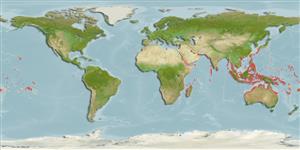>
Mugiliformes (Mullets) >
Mugilidae (Mullets)
Etymology: Crenimugil: Latin, crenulatus = cut, clipped + Latin, mugil = grey mullet (Ref. 45335).
Environment: milieu / climate zone / depth range / distribution range
Ecología
marino; agua dulce; salobre asociado a arrecife; catadromo (Ref. 46888); rango de profundidad 0 - 3 m (Ref. 86942). Tropical; 35°N - 32°S, 28°E - 135°W
Indo-Pacific: Red Sea, south to Transkei, South Africa (Ref. 4393) and east to the Hawaiian and Marquesan islands, north to southern Japan, south to New Caledonia and Norfolk Island (Ref. 8879) and Tuamotu Islands (Ref. 90102).
Tamaño / Peso / Age
Maturity: Lm ? range ? - ? cm
Max length : 60.0 cm TL macho / no sexado; (Ref. 9710); common length : 40.0 cm TL macho / no sexado; (Ref. 5450); peso máximo publicado: 8.0 kg (Ref. 37816)
Espinas dorsales (total): 5; Radios blandos dorsales (total): 8-9; Espinas anales 3; Radios blandos anales: 9. Diagnosis: Characterized by having membranous, digitate posterior margin on scales; snout shorter than eye diameter; slender maxilla and weakly curved ventrally at posterior tip, partially or completely concealed; poorly developed adipose eyelid as rim around eye; preorbital weakly concave on anteroventral edge (Ref. 90102).
Found in coastal waters but enters estuaries and rivers where they feed on microalgae, filamentous algae, forams, diatoms, and detritus associated with sand and mud (Ref. 9812). Form schools. Oviparous, eggs are pelagic and non-adhesive (Ref. 205). Also caught using stakenets, barrier nets, and pouch nets during spawning; also taken as bycatch (Ref. 9812). Marketed fresh and perhaps salted, boiled (Thailand), canned or frozen (Australia); roe salted (Ref. 9812).
Life cycle and mating behavior
Madurez | Reproducción | Puesta | Huevos | Fecundidad | Larva
Myers, R.F., 1991. Micronesian reef fishes. Second Ed. Coral Graphics, Barrigada, Guam. 298 p. (Ref. 1602)
IUCN Red List Status (Ref. 130435)
Threat to humans
Harmless
Human uses
Pesquerías: comercial
Más información
ReferenciasAcuiculturaPerfil de acuiculturaRazasGenéticaElectrophoresesheritabilidadEnfermedadesProcesamientoNutrientsMass conversion
Herramientas
Special reports
Download XML
Fuentes de Internet
Estimates based on models
Preferred temperature (Ref.
123201): 25.2 - 29.3, mean 28.5 °C (based on 3155 cells).
Phylogenetic diversity index (Ref.
82804): PD
50 = 0.5625 [Uniqueness, from 0.5 = low to 2.0 = high].
Bayesian length-weight: a=0.01202 (0.01055 - 0.01370), b=2.96 (2.93 - 2.99), in cm total length, based on LWR estimates for this species (Ref.
93245).
Nivel trófico (Ref.
69278): 2.3 ±0.14 se; based on food items.
Generation time: 4.8 ( na - na) years. Estimated as median ln(3)/K based on 2
growth studies.
Resiliencia (Ref.
120179): Medio, población duplicada en un tiempo mínimo de 1.4-4.4 años (K=0.23-0.28).
Prior r = 0.35, 95% CL = 0.23 - 0.53, Based on 2 stock assessments.
Fishing Vulnerability (Ref.
59153): Moderate vulnerability (40 of 100).
Climate Vulnerability (Ref.
125649): Very high vulnerability (82 of 100).
Nutrients (Ref.
124155): Calcium = 53.4 [20.9, 168.7] mg/100g; Iron = 0.614 [0.274, 1.463] mg/100g; Protein = 19.1 [17.2, 20.9] %; Omega3 = 0.145 [0.069, 0.311] g/100g; Selenium = 21.9 [11.0, 49.6] μg/100g; VitaminA = 53.2 [11.9, 234.3] μg/100g; Zinc = 1.74 [1.10, 2.70] mg/100g (wet weight); based on
nutrient studies.
